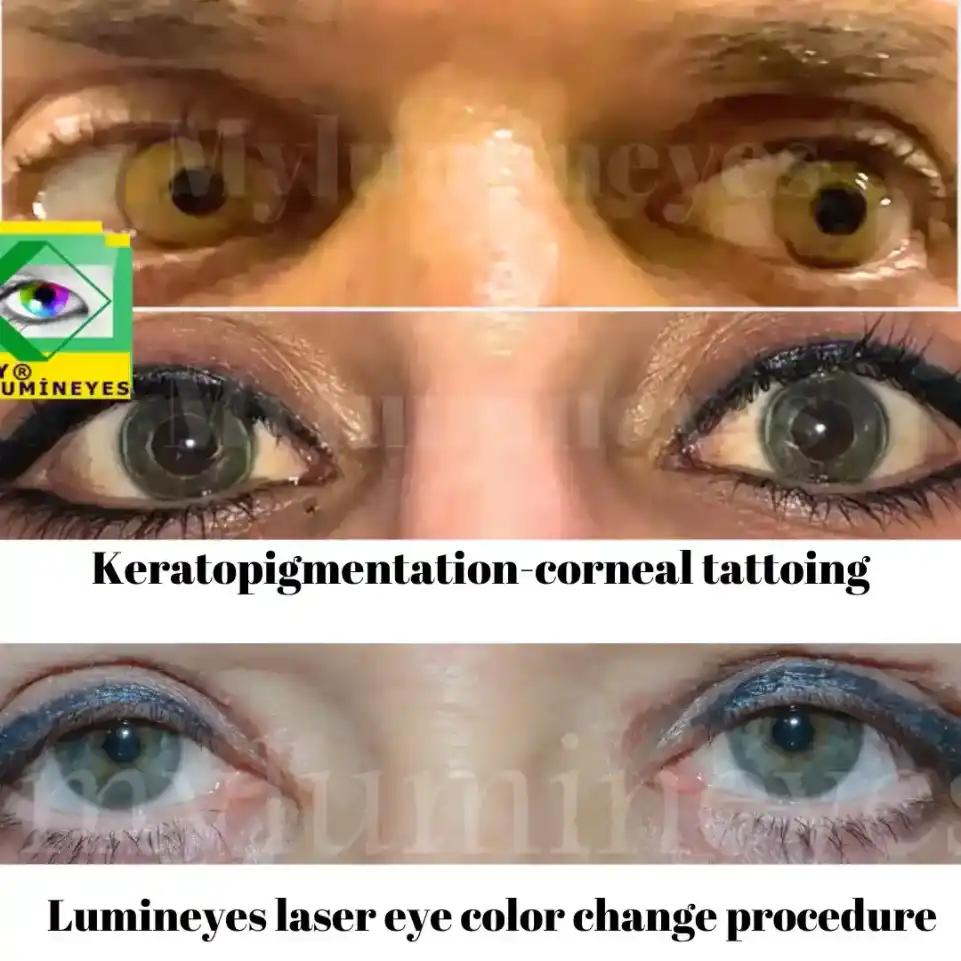Types of Eye Color Change Surgery: A Complete Guide to Permanent Options

- Understanding How Eye Color Change Surgery Works
- Type 1: Keratopigmentation (Corneal Tattooing)
- Type 2: Laser Depigmentation (Pigment Removal)
- Type 3: Iris Implant Surgery
- Comparing the Three Types: Iris Implants vs. Keratopigmentation vs. Laser Depigmentation
- Current Regulatory Status and Medical Consensus
- Who Might Be a Candidate?
- Making an Informed Decision
- The Future of Eye Color Change Surgery
- Final Thoughts: Weighing Your Options
- FAQ: Types of Eye Color Change Surgery (2025)
Dreaming of trading your brown eyes for striking blue or transforming your natural color into something entirely new? The world of cosmetic eye color change surgery has evolved dramatically, offering several permanent options that promise to revolutionize your appearance. But with different procedures available, understanding exactly how each type works—and what they involve—is crucial for making an informed decision.
From high-tech laser procedures to surgical implants, the landscape of permanent eye color change has become increasingly sophisticated. Let's explore the three main types of eye color change surgery currently available, examining how each procedure works, what to expect, and what makes them different.
Understanding How Eye Color Change Surgery Works
Before diving into specific procedures, it's important to understand that eye color comes from melanin, the same pigment that determines skin and hair color. Your iris contains different amounts of melanin, which creates the spectrum from deep brown to light blue eyes. The various surgical approaches work by either:
- Adding pigment to change the apparent color
- Removing existing pigment to reveal lighter colors underneath
- Replacing the iris entirely with a prosthetic
Each method achieves permanent results but through completely different mechanisms and with varying levels of complexity, safety, and customization options.
Type 1: Keratopigmentation (Corneal Tattooing)
How Keratopigmentation Works
Keratopigmentation, also known as corneal tattooing, represents the newest and most scientifically studied approach to permanent eye color change. This procedure doesn't actually change your iris color—instead, it creates a colored layer over it by injecting pigment into the cornea itself.
The process involves several precise steps:
- Tunnel Creation: A femtosecond laser creates a circular tunnel within the corneal tissue at a specific depth (typically 250+ micrometers to avoid nerve stimulation)
- Pigment Injection: Specially formulated mineral-based pigments are injected through the tunnel using a fine cannula
- Color Distribution: The pigment spreads evenly within the corneal layer, creating a uniform appearance

What Makes Keratopigmentation Different
Precision and Customization: The procedure offers remarkable color control, with clinics typically offering 7-11 different shades ranging from natural browns and blues to more dramatic grays and greens. Patients can even preview their potential results through computer simulation.
Quick Procedure: The actual laser work takes only about 20 seconds per eye, with the entire appointment lasting approximately 20 minutes.
Immediate Results: Unlike other procedures, the color change is visible immediately after the procedure, though some settling may occur over the following weeks.
Recovery and Results
Most patients experience minimal discomfort, similar to LASIK surgery. Recovery typically involves:
- Days 1-3: Minor pressure sensation and light sensitivity
- Week 1: Gradual reduction in any inflammation
- Weeks 2-4: Complete healing and final color stabilization
Research published in medical journals shows that 90% of patients achieve excellent cosmetic results, with 92.5% reporting complete satisfaction with their outcome Cornea Journal.
Type 2: Laser Depigmentation (Pigment Removal)
How Laser Depigmentation Works
Laser depigmentation takes a completely different approach—rather than adding color, it removes existing brown pigment to reveal the lighter colors naturally present underneath. This procedure uses targeted laser energy to break down melanin-producing cells in the iris.
The Technical Process:
- Low-energy laser beams (typically 532-nm wavelength Nd:YAG lasers) heat and destroy brown pigment cells
- Multiple sessions are usually required, with treatments spaced weeks apart
- Progressive lightening occurs as the body naturally absorbs the destroyed pigment
Unique Characteristics of Laser Depigmentation
Natural Color Revelation: This procedure can only reveal colors that already exist beneath the brown pigment layer. Most people have blue or gray undertones, but the exact final color cannot be precisely predicted.
Limited Color Options: Unlike keratopigmentation, you cannot choose from a palette of colors. The procedure typically changes brown eyes to blue, gray, or green, depending on your natural underlying pigmentation.
Gradual Results: Changes become apparent over 4-8 weeks as the body processes the destroyed pigment cells.

Session Requirements
Most patients require:
- 3-5 treatment sessions spaced 2-4 weeks apart
- 200-400 laser pulses per session
- Ongoing assessment to monitor progress and avoid over-treatment
The procedure is performed on an outpatient basis and typically involves minimal discomfort with topical anesthetic drops.
Type 3: Iris Implant Surgery
How Iris Implant Surgery Works
Iris implant surgery is the most invasive option, involving the surgical placement of a colored silicone prosthetic directly over your natural iris. Originally developed in 1956 for medical conditions involving iris damage, it has been adapted for cosmetic use.
Surgical Process:
- Incision Creation: A small cut is made where the cornea meets the sclera (white of the eye)
- Implant Insertion: The folded silicone iris is inserted through the incision
- Positioning: The implant is unfolded and positioned over the natural iris
- Suturing: The incision is closed with fine sutures
Iris Implant Characteristics
Immediate Dramatic Change: Results are visible immediately after surgery, offering the most dramatic transformation of all procedures.
Complete Color Control: Available in various stock colors including blue, green, brown, and black, with custom options for matching one eye to another.
Surgical Complexity: This is the most invasive procedure, requiring actual surgery within the eye rather than laser treatment.

Recovery Considerations
Recovery from iris implant surgery typically involves:
- 24-48 hours: Eye patches and restricted activity
- 1 week: Gradual vision clearing and reduced sensitivity
- 2-8 weeks: Complete healing, depending on individual factors
Comparing the Three Types: Iris Implants vs. Keratopigmentation vs. Laser Depigmentation
Safety Profiles
Keratopigmentation has the most extensive safety research, with studies following patients for up to 69 months. Complications are relatively rare, with light sensitivity being the most common temporary side effect.
Laser Depigmentation shows promising results in limited studies, but long-term data is still being collected. The procedure appears less invasive than implants but more research is needed.
Iris Implants carry the highest risk profile, with studies showing serious complications in up to 92% of cosmetic cases, including glaucoma, corneal damage, and potential vision loss American Journal of Ophthalmology.
Customization Options
| Procedure Type | Color Choices | Predictability | Reversibility |
|---|---|---|---|
| Keratopigmentation | 7-11 shades, highly customizable | Highly predictable results | Not reversible |
| Laser Depigmentation | Limited to underlying natural colors | Unpredictable final shade | Not reversible |
| Iris Implants | Wide color selection available | Predictable immediate results | Surgically reversible |
Cost Considerations
Permanent eye color change options vary significantly in cost:
- Keratopigmentation: $12,000-$13,000
- Laser Depigmentation: $5,000-$7,000+
- Iris Implants: Variable (often performed overseas)
Recovery Time Comparison
Keratopigmentation: 2-3 days for normal function, 1-3 weeks for complete healing
Laser Depigmentation: Minimal downtime between sessions, 4-8 weeks for final results
Iris Implants: 2-8 weeks for complete recovery
Current Regulatory Status and Medical Consensus
It's crucial to understand that no eye color change procedure has FDA approval for cosmetic purposes in the United States. The American Academy of Ophthalmology issued warnings in 2024 about all cosmetic eye color procedures, emphasizing that they "carry serious risks for vision loss and complications" American Academy of Ophthalmology.
Medical Professional Perspectives
Leading ophthalmologists generally agree that:
- Colored contact lenses remain the safest option for changing eye color
- Surgical procedures carry inherent risks that may outweigh cosmetic benefits
- Long-term studies are still needed for newer procedures like keratopigmentation
- Patient selection and informed consent are crucial for any surgical intervention
Who Might Be a Candidate?
Ideal Candidates Generally Include:
- Adults over 21 with stable vision
- Individuals with realistic expectations about results and risks
- People with healthy eyes free from conditions like glaucoma or severe dry eye
- Those who understand the permanent nature of these procedures
Who Should Avoid These Procedures:
- Individuals with active eye diseases or infections
- People with unrealistic expectations about results
- Those seeking easily reversible changes
- Patients with certain medical conditions affecting healing
Making an Informed Decision
When considering permanent eye color change options, research suggests that keratopigmentation currently offers the best combination of safety data, predictable results, and patient satisfaction. However, each procedure carries risks that must be carefully weighed against potential benefits.
Questions to Ask Your Surgeon:
- How many procedures have you performed of each type?
- What is your complication rate for each procedure?
- Can you provide before/after photos of similar cases?
- What are the specific risks for my individual case?
- What happens if I'm not satisfied with the results?
The Future of Eye Color Change Surgery
As technology advances, we're likely to see continued refinement of existing procedures and development of new techniques. Research into reversible methods, improved pigment formulations, and enhanced safety protocols continues worldwide.
The field is also moving toward better patient selection criteria and standardized safety protocols as more long-term data becomes available.
Final Thoughts: Weighing Your Options
Understanding the different types of eye color change surgery helps you make an informed decision about whether any of these procedures align with your goals and risk tolerance. While the technology has advanced significantly, these remain surgical procedures with inherent risks.
Remember: Your vision is irreplaceable. Any cosmetic procedure on your eyes should be approached with careful consideration, thorough research, and consultation with qualified medical professionals. Consider starting with colored contact lenses to experience your desired look before committing to permanent surgical changes.
Whether you're drawn to the precision of keratopigmentation, the natural approach of laser depigmentation, or considering iris implants, understanding how each procedure works empowers you to have meaningful discussions with medical professionals and make the choice that's right for your unique situation.
FAQ: Types of Eye Color Change Surgery (2025)
This article is for informational purposes only and should not replace professional medical advice. Always consult with a qualified ophthalmologist for personalized medical guidance regarding eye procedures.

Leave a Reply